

Teaching Tolerance - Diversity, Equity and Justice. As more and more emphasis is placed on improving academic outcomes, it can begin to feel as if there just isn’t enough time for relationship building and social-emotional learning.
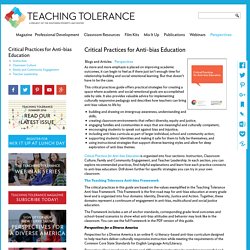
But that doesn’t have to be the case. This critical practices guide offers practical strategies for creating a space where academic and social-emotional goals are accomplished side by side. It also provides valuable advice for implementing culturally responsive pedagogy and describes how teachers can bring anti-bias values to life by. The 4 Components of a DIY Professional Development Toolkit. Education has always been a reflection of broader cultural values.
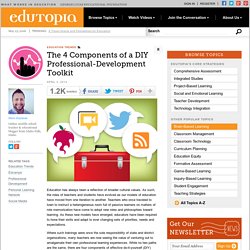
As such, the roles of teachers and students have evolved as our models of education have moved from one iteration to another. Teachers who once traveled to town to instruct a heterogeneous room full of passive learners on matters of rote memorization have come to adopt new roles and philosophies toward learning. As these new models have emerged, educators have been required to hone their skills and adapt to ever changing sets of priorities, needs and expectations. Where such trainings were once the sole responsibility of state and district organizations, many teachers are now seeing the value of venturing out to amalgamate their own professional learning experiences. While no two paths are the same, there are four components of effective do-it-yourself (DIY) professional development that all educational professionals should consider. Twitter I finally understand how much differentiated learning matters. Blogs Edcamps. Summer Professional Development with MOOCs.
What is a MOOC, you ask?
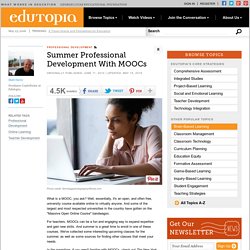
Well, essentially, it's an open, and often free, university course available online to virtually anyone. And some of the largest and most respected universities in the country have gotten on the "Massive Open Online Course" bandwagon. For teachers, MOOCs can be a fun and engaging way to expand expertise and gain new skills. And summer is a great time to enroll in one of these courses. We've collected some interesting upcoming classes for the summer, as well as some sources for finding other classes that meet your needs. In the meantime, if you aren't familiar with MOOCs, check out The New York Times video below, which explains the ins and outs of this relatively new educational concept.
Upcoming MOOCs to Consider Teaching Statistics Through Data Investigations: Data is changing the world, and students must be prepared to use it in their careers. Online Teaching and Learning in K-12: The web is a powerful tool for engaging and teaching students. Create Real Change: Create a Quality Learning Experience. If you're confused or overwhelmed with the process of taking your content, ideas or expertise, and creating a course, workshop or presentation out of them, this 12 Step Challenge will give you the Blueprint for getting started.
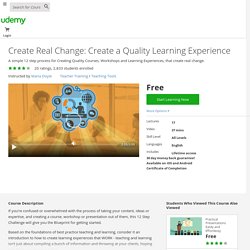
Teaching Tolerance - Diversity, Equity and Justice. If educators have learned anything in the last decade of school reform initiatives it is that one size does not fit all.

Differentiated Instruction (DI) is an approach where teachers proactively plan varied approaches to what students need to learn, how they will learn it and how they express what they've learned. Differentiated Instruction is teaching with the child in mind rather than adopting a standardized approach to teaching and learning that seems to presume that all students of a given age are at the exact same place academically. DI is responsive teaching. Differentiated Instruction gives students a range of ways to access curriculum, instruction and assessment. DI engages students to interact and participate in the classroom in a richer way. Meet Michelle Rainey. Teaching Tolerance - Diversity, Equity and Justice. Background, life experiences, personal biases and cultural stereotypes can influence how we perceive others.
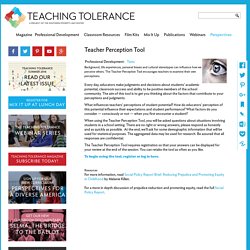
The Teacher Perception Tool encourages teachers to examine their own perceptions. Every day, educators make judgments and decisions about students’ academic potential, classroom success and ability to be positive members of the school community. The aim of this tool is to get you thinking about the factors that contribute to your perceptions and judgments. What influences teachers' perceptions of student potential? How do educators' perception of this potential influence their expectations and student performance? Culture in the Classroom. Educators today hear a lot about gaps in education – achievement gaps, funding gaps, school-readiness gaps.
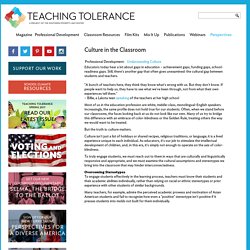
Still, there's another gap that often goes unexamined: the cultural gap between students and teachers. "A bunch of teachers here, they think they know what's wrong with us. But they don't know. Reasonable Teaching: The 13x4 to Master The Art of Teaching by Tom Cassidy (and 4 others) Tom Cassidy - Comprehensivist, Education Reformer, Reasonable Polymath, using continuous development frameworks to help people improve all areas of their lives: self-worth, self-belief, goal-achieving, feeling good, achieving sustainable health and deeply fulfilling relationships.
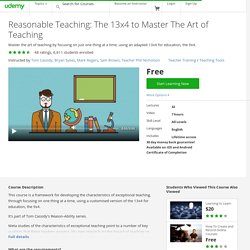
My mantra is: 'Feel Good. Do Stuff.' Life's not about meditating on the top of a mountain in Nepal, feeling great, achieving enlightenment for yourself... And it's definitely not about going through life doing things, without having awareness, being busy, achieving a lot but not being mindful of the bigger picture. It's about both. Feel good. Four Strategies for Building Relationships With Students. With the push for accreditations and student test scores, many teachers are using every instructional minute for what they are intended for: instruction.

However, maximizing academic time often comes at the cost of minimizing time spent building relationships. That doesn’t have to be the case. A little patience and a few adaptable strategies can help educators prioritize relationship building and effective instruction. Here are four strategies I use to connect with students and to build stronger relationships. Create student-defined rules of respect. Teachers often have students help with classroom rules. This year, my students sit in “colleague committees.” Correct behaviors using I-messages.